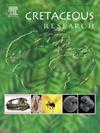中国东北早白垩世热河生物群中蜂类新种(膜翅目)
IF 1.7
3区 地球科学
Q1 GEOLOGY
引用次数: 0
摘要
叶蜂科是膜翅目昆虫的两个亚目之一,是膜翅目昆虫中最基础的分支之一。这里3属3种,其中一个属和三个物种被认为是新的科学,描述和插图尖山沟黟县形成西方的辽宁、东北中国,包括Tuphephialtites不多sp. 11月,Crephanogaster beipiaoensis sp. 11月,和Chorephialtites longispinus将军等sp. 11月到目前为止共3属5种亚科内Ephialtitinae被从中间热河生物群在中国东北,表明早白垩世在中国东北地区有很高的形态差异。1990年在俄罗斯外贝加尔湖图尔加组和中国东北义县组均发现拉斯尼琴Crephanogaster Rasnitsyn,证实了这两个组为同时期沉积。此外,还给出了一种属的钥匙。本文章由计算机程序翻译,如有差异,请以英文原文为准。
New ephialtitid wasps (Hymenoptera) of the Early Cretaceous Jehol Biota from NE China
The Jurassic-Early Cretaceous family Ephialtitidae is considered as one of the most basal lineages of Apocrita, one of two suborders of the insect order Hymenoptera. Herein three genera and three species, of which one genus and three species are recognized as new to science, are described and illustrated from the Jianshangou Bed of the lower Yixian Formation of western Liaoning, NE China, including Tuphephialtites wangi sp. nov., Crephanogaster beipiaoensis sp. nov., and Chorephialtites longispinus gen. et sp. nov. So far a total of three genera and five species within the subfamily Ephialtitinae are known from the middle Jehol Biota in NE China, suggesting a high morphological disparity of Ephialtitidae during the Early Cretaceous in NE China. Occurrence of Crephanogaster Rasnitsyn, 1990 in both the Turga Formation of Transbaikalia, Russia and the Yixian Formation of NE China confirms these two formations are of coeval deposits. Additionally, a key to the genera of Ephialtitinae is given.
求助全文
通过发布文献求助,成功后即可免费获取论文全文。
去求助
来源期刊

Cretaceous Research
地学-地质学
CiteScore
4.10
自引率
19.00%
发文量
235
审稿时长
12 weeks
期刊介绍:
Cretaceous Research provides a forum for the rapid publication of research on all aspects of the Cretaceous Period, including its boundaries with the Jurassic and Palaeogene. Authoritative papers reporting detailed investigations of Cretaceous stratigraphy and palaeontology, studies of regional geology, and reviews of recently published books are complemented by short communications of significant new findings.
Papers submitted to Cretaceous Research should place the research in a broad context, with emphasis placed towards our better understanding of the Cretaceous, that are therefore of interest to the diverse, international readership of the journal. Full length papers that focus solely on a local theme or area will not be accepted for publication; authors of short communications are encouraged to discuss how their findings are of relevance to the Cretaceous on a broad scale.
Research Areas include:
• Regional geology
• Stratigraphy and palaeontology
• Palaeobiology
• Palaeobiogeography
• Palaeoceanography
• Palaeoclimatology
• Evolutionary Palaeoecology
• Geochronology
• Global events.
 求助内容:
求助内容: 应助结果提醒方式:
应助结果提醒方式:


